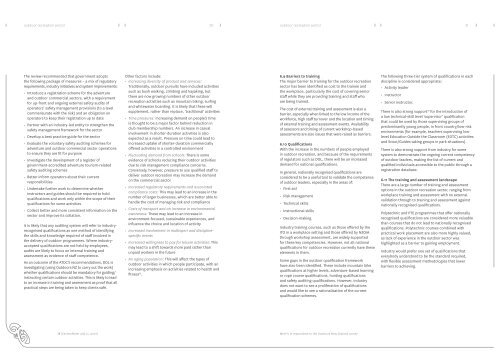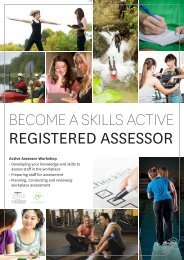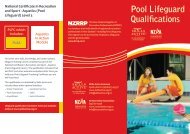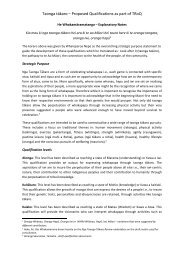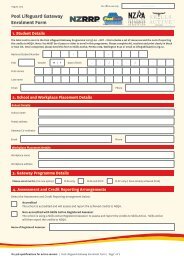outdoor recreation sector28 outdoor recreation sector29volunteer time involved. However,there seems to be a downwardtrend in volunteerism in the sports,fitness and leisure sector overall 12 .Conversely, some organisations havewaiting lists and more volunteersthan they need 13 . Whatever thetrend, volunteers continue toplay an important role in outdoorrecreation and are the cornerstonefor organisations such as Scouts,Girl Guides, Mountain Safety Counciland other community-based groupswho, between them, have volunteerleaders numbered in the thousands.It is generally thought to be moredifficult to engage volunteers intraining if the training does notrelate directly to the underlyingbenefits sought by volunteers. Afurther significant barrier to trainingvolunteers is cost, as organisationsusing a voluntary labour force maylack funding to train them.<strong>Training</strong> that improves themanagement of volunteers is alsocritical to the effective use of avolunteer workforce.Business sizeThe average business in therecreation sector is small, with therecent Outdoors New Zealand surveyindicating that 49% of businessesemployed fewer than 5 staff,including the owner.Business drivers, goals, cultureand working conditions vary acrossthe sector and these will affectattitudes to training. Generally,small businesses are less likelyto have the capacity to deliverinternal training and assessment,especially to a nationally recognisedstandard. The diversity of activitiesoffered by an organisation will alsoadversely affect their capabilityto deliver training internally to anational standard. In general, smallbusinesses are more likely to requireexternal assistance with trainingthan large ones.6.4 Volume of trainingThere was a small reduction in theamount of training by registeredproviders against standards onthe New Zealand QualificationFramework (NZQF) over the period2003 - 2006. Over the same periodshort-course completions assessedby New Zealand Outdoor InstructorsAssociation (NZOIA) remained static,at approximately 90 assessmentsper year.Anecdotally, this reduction may berelated to an increase in training thatis not based on national qualificationsand is therefore not captured in theNQF. This assumption needs to betested and the benefits of greateruptake of national qualificationsinvestigated. The targeted review ofqualifications (TRoQ) currently underway will provide an opportunity toinvestigate this.6.5 ProductivityThe outdoor recreation sector makesan important contribution in termsof economic output and employment.Tourism is a very large export earnerand, while not all tourists participatein adventure activities, theseactivities are often the inspiration fortravelling to New Zealand.Other contributions that impact onproductivity more generally include:• Overall physical, spiritual andemotional wellbeing – the outdoorrecreation sector contributes tooverall quality of life. Participationis seen as being likely to prolongand enhance quality of life• Social benefits – enhancedproductivity due to a healthierworkforce, and reducedsocial costs from lowercrime (by engaging peoplein personal developmentactivities and connectingthem with their community)• Environment – recognising theintrinsic value of the outdoors• National identity and culture– what it means to be a NewZealander; the relationshipwith the outdoors and asense of belonging.6.6 The training environmentImproving the skills of individualsleads to a higher-quality serviceand better client satisfaction, andmay allow organisations increasecharges and pay higher wages.Greater worker completion ofqualifications is seen as a way toimprove personal skills and providegreater customer satisfaction.Qualifications build worker skills,through an accumulation of personalexperience and knowledge, toenable them to respond to a rangeof complex situations.A large number of organisationsplay a role in meeting the outdoorrecreation skill needs, with a widerange of education and trainingoptions available. They include <strong>Skills</strong><strong>Active</strong> <strong>Aotearoa</strong>, tertiary educationproviders (including universities,ITPs and PTEs), employersthemselves, and a range of sectorspecificorganisations, notably theNew Zealand Outdoor InstructorsAssociation, Mountain SafetyCouncil (MSC) and New ZealandMountain Guides Association.For the relatively small workforce,the variety of qualificationsavailable, along with the numberof providers able to offer them, is confusing for thosewanting to gain qualifications and for the consumerswho use the services of those who are qualified. Aninitiative to align the qualifications offered by NZOIA,MSC and <strong>Skills</strong> <strong>Active</strong> to a single set of qualifications onthe NZQF was begun in late 2009. In 2011 NZOIA decidednot to continue with this alignment, while MSC and <strong>Skills</strong><strong>Active</strong> remain committed to reducing the proliferation ofstandards. The TROQ review will aid in the reduction ofqualifications on the NZQF, and will be welcomed.6.7 Current and future training needsThe main demand from the sector is for external trainingand assessment against technical skills related tospecific disciplines. The preferred delivery methodsfor qualifications are workplace delivery/assessmentand short workshop training and assessment. As thetechnical skills element of qualifications increases, thesector seeks greater surety of the standard being met,through external assessment. Qualifications are likelyto continue to grow in importance with the increase inregulatory compliance requirements (see Section 6.8).<strong>Training</strong> focused on the ‘softer’ skills, such as groupmanagement and communication, may not need to beexternally validated, so is well suited to being deliveredin the workplace. Vocational training courses thatexceed 3 months need to focus on giving the traineepractical experiences in the outdoor recreationsector, and should also result in nationally recognisedqualifications being achieved.In the medium term there is likely to be a growth indemand for outdoor recreation staff to hold nationallyrecognised qualifications. However, there continuesto be some duplication of qualifications that needs tobe rationalised so employers and employees can getbetter value from the outdoor recreation qualificationframework. While there is pressure from the sectorto rationalise the number of qualifications offered,some growth is still expected in the ‘strands’ of thesequalifications as more activities, such as canyoning forexample, become commercial ventures.Inexperience and the lack of a nationally recognisedqualification 14 are seen as major barriers to employinggeneral instructors/guides. Water sports instructors orguides are more difficult vacancies to fill than dry activityvacancies. Workplaces have to spend a significantamount of time training or mentoring new staff, becauseof this qualification and experience gap.Specific skill shortages in new staff are identified as:• Group management• Technical (activity) skills• Instructional skills• Risk managementThe most commonly identified skills developmentrequirements for current staff are:• Technical competency• Instructional skills• Group management• Facilitation skills• First aid• Outdoor risk management and decision-making.• Audit• Leadership• Kaupapa Māori approaches to training• Te Ao Turoa – Traditional Māori approach to outdoorrecreation with application of tikanga to environmentalcontexts. There is an existing qualification but uptakeis low.6.8 External pressuresThe Department of Labour (DOL) report ‘Review of RiskManagement and Safety in the Adventure Tourism andOutdoor Commercial <strong>Sector</strong>s in New Zealand 2009/10’(ATOC) was sparked by concerns about a number ofserious incidents in the adventure tourism and outdoorcommercial sector. The review’s range of enquiry wasdefined as 44 adventure and outdoor commercial sectoractivity types.The review team’s main conclusions were:• There does not appear to be a fundamental problem inthe sector’s ability to develop appropriate safety systems• However, there are gaps in the safety managementframework that allow businesses to operate atdifferent standards from those generally accepted• While these gaps remain there is not enough assurancethat preventable accidents will not occur• This situation could result in harm to individuals andtheir families, and damage to New Zealand’s reputationas an international visitor destination12 (The Sports, Fitness and Leisure Ministerial Taskforce 2001)13 www.ocvs.govt.nz Office for the Community and Voluntary <strong>Sector</strong> (OCVS).14 (Outdoors New Zealand and <strong>Skills</strong> <strong>Active</strong> <strong>Aotearoa</strong> 2010).
outdoor recreation sector30 outdoor recreation sector31The review recommended that government adoptsthe following package of measures − a mix of regulatoryrequirements, industry initiatives and system improvements:• Introduce a registration scheme for the adventureand outdoor commercial sectors, with a requirementfor up-front and ongoing external safety audits ofoperators’ safety management provisions (to a levelcommensurate with the risk) and an obligation onoperators to keep their registration up to date• Partner with an industry-led entity to strengthen thesafety management framework for the sector• Develop a best practice guide for the sector• Evaluate the voluntary safety auditing schemes foradventure and outdoor commercial sector operationsto ensure they are fit for purpose• Investigate the development of a register ofgovernment-accredited adventure tourism-relatedsafety auditing schemes• Better inform operators about their currentresponsibilities• Undertake further work to determine whetherinstructors and guides should be required to holdqualifications and work only within the scope of theirqualifications for some activities• Collect better and more consistent information on thesector and improve its collation.It is likely that any auditing system will refer to industryrecognisedqualifications as one method of identifyingthe skills and knowledge required of staff involved inthe delivery of outdoor programmes. Where industryacceptedqualifications are not held by employees,audits are likely to focus on internal training andassessment as evidence of staff competence.As an outcome of the ATOC’s recommendations, DOL isinvestigating (using Outdoors NZ to carry out the work)whether qualifications should be mandatory for guiding/instructing certain outdoor activities. This is likely to leadto an increase in training and assessment as proof that allpractical steps are being taken to keep clients safe.Other factors include: • Increasing diversity of product and services:Traditionally, outdoor pursuits have included activitiessuch as bush walking, climbing and kayaking, butthere are now growing numbers of other outdoorrecreation activities such as mountain biking, surfingand whitewater boarding. It is likely that these willsupplement, rather than replace, ‘traditional’ activities• Time pressures: Increasing demand on people’s timeis thought to be a major factor behind reduction inclub membership numbers. An increase in casualinvolvement in shorter-duration activities is alsoexpected as a result. Pressure on time could lead toincreased uptake of shorter-duration commerciallyoffered activities in a controlled environment• Fluctuating demand from schools: There is someevidence of schools reducing their outdoor activitiesdue to risk management compliance concerns.Conversely, however, pressure to use qualified staff todeliver outdoor recreation may increase the demandon the commercial sector• Increased regulatory requirements and associatedcompliance costs: This may lead to an increase in thenumber of larger businesses, which are better able to handle the cost of managing risk and compliance• Costs of transport and an increase in environmentalawareness: These may lead to an increase inenvironment-focused, sustainable experiences, andinfluence the choice and location of activity• Increased involvement in multisport and disciplinespecificevents• Increased willingness to pay for leisure activities: Thismay lead to a shift towards more paid rather thanunpaid workers in the future• An aging population: This will affect the types ofoutdoor activities in which people participate, with anincreasing emphasis on activities related to health andfitness 15 .6.9 Barriers to trainingThe major barrier to training for the outdoor recreationsector has been identified as cost to the trainee andthe workplace, particularly the cost of covering seniorstaff while they are providing training and staff whoare being trained.The cost of external training and assessment is also abarrier, especially when linked to the low income of theworkforce, high staff turnover and the location and timingof external training and assessment events. Availabilityof assessors and timing of current workshop-basedassessments are also issues that were raised as barriers.6.10 QualificationsWith the increase in the numbers of people employedin outdoor recreation, and because of the requirementsof regulators such as DOL, there will be an increaseddemand for national qualifications.In general, nationally recognised qualifications areconsidered to be a useful tool to validate the competenceof outdoor leaders, especially in the areas of:• First aid• Risk management• Technical skills• Instructional skills• Decision-making.Industry training courses, such as those offered by theITO in a workplace setting and those offered by NZOIAthrough workshop assessment, are widely supportedfor these key competencies. However, not all nationalqualifications for outdoor recreation currently have theseelements in them.Some gaps in the outdoor qualification frameworkhave also been identified. These include mountain bikequalifications at higher levels, adventure-based learningor rope course qualifications, hunting qualificationsand safety auditing qualifications. However, industrydoes not want to see a proliferation of qualificationsand would like to see a rationalisation of the currentqualification schemes.The following three-tier system of qualifications in eachdiscipline is considered appropriate:• Activity leader• Instructor• Senior instructor.There is also strong support 16 for the introduction ofa low technical-skill level ‘supervisor’ qualificationthat could be used by those supervising groups ofpredominantly young people, in front country/low-riskenvironments (for example, teachers supervising lowlevelEducation Outside the Classroom (EOTC) activitiesand Scout/Guides taking groups in park situations).There is also strong support from industry for somesystem to demonstrate the ongoing current competencyof outdoor leaders, making the list of current andqualified individuals accessible to the public through aregistration database.6.11 The training and assessment landscapeThere are a large number of training and assessmentoptions in the outdoor recreation sector, ranging fromworkplace training and assessment with no externalvalidation through to training and assessment againstnationally recognised qualifications.Polytechnic and PTE programmes that offer nationallyrecognised qualifications are considered more valuablethan courses that do not lead to nationally recognisedqualifications. Polytechnic courses combined withpractical work placement are also more highly valued,as lack of experience in the outdoor sector washighlighted as a barrier to gaining employment.Industry would prefer one set of qualifications thateverybody understood to be the standard required,with flexible assessment methodologies that lowerbarriers to achieving.15 (Eschenfelder and Li, 2007)16 81% of respondent to the Outdoors New Zealand survey


